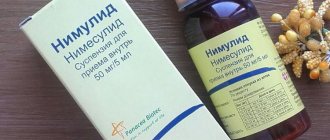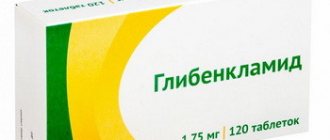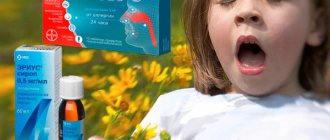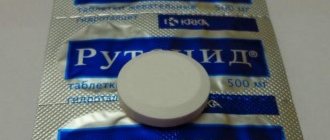Release form and composition
Dosage forms:
- Lingual tablets: pale yellow, round, biconvex (10 pieces in a blister made of polyvinyl chloride or aluminum foil, 1 or 2 blisters in a cardboard pack);
- Tablets: light yellow in color, round biconvex shape, with a logo on one side and the inscription “NIMULID” on the other (10 pieces in a blister of polyvinyl chloride or aluminum foil, in a cardboard pack of 1, 2, 3 or 10 blisters );
- Gel for external use 1%: translucent mass with a uniform yellowish structure (10, 20 or 30 g in aluminum or plastic tubes, 1 tube in a cardboard box);
- Suspension for oral administration (60 ml in dark glass bottles, 1 bottle in a cardboard package complete with a measuring cup).
The active ingredient of Nimulid is nimesulide:
- 1 lingual tablet – 100 mg;
- 1 tablet – 100 mg;
- 1 g of gel – 10 mg;
- 1 ml of suspension – 10 mg.
Auxiliary components:
- Lingual tablets: croscarmellose sodium, mannitol, sodium carboxymethyl starch, magnesium stearate, sodium methyl parahydroxybenzoate, potassium sorbate, sodium propyl parahydroxybenzoate, colloidal silicon dioxide, orange flavor, aspartame, purified water;
- Tablets: corn starch, croscarmellose sodium, lactose, colloidal silicon dioxide, povidone, polysorbate, sodium docusate, magnesium stearate, hydrochloric acid and purified water - removed during the production process;
- Gel: carbomer, hyprolose, ethanol 95% (purified), triacetin, phosphoric acid, dimethylacetamide, flavor 0106-G, flavor MSC-03, purified water;
- Suspension: sorbitol solution 70% non-crystallized, xanthan gum, citric acid monohydrate, glycerin, macrogol glyceryl hydroxystearate (Cremophor RH-40), sucrose, sodium disulfite, sodium methyl parahydroxybenzoate, sodium benzoate, sodium propyl parahydroxybenzoate, colloidal silicon dioxide, hydrochloric acid, quinoline yellow dye , flavoring (vanilla and mango), purified water.
Nimulid price, where to buy
The cost of the medication depends on the dosage form, pharmacy chain, and region.
The price of Nimulid in tablets 100 mg is 200-320 rubles. The price of the suspension is 110-150 rubles. The price of Nimulid gel is 200-260 rubles. The drug is not sold as an ointment.
- Online pharmacies in RussiaRussia
- Online pharmacies in KazakhstanKazakhstan
ZdravCity
- Nimulid Susp.
for internal approx. 50mg/5ml 60mlPanacea Biotec RUB 224 order - Nimulid tablets for rassas. 100 mg 10 pcs Panacea Biotec
RUB 228 order
- Nimulid tablets 100 mg 20 pcs.Panacea Biotec
RUB 248 order
- Nimulid tablets for rassas. 100 mg 20 pcs Panacea Biotec
RUB 356 order
- Nimulid tablets 100 mg 30 pcs.Panacea Biotec
RUB 353 order
Pharmacy Dialogue
- Nimulid suspension bottle 50mg/5ml 60mlPanacea Biotec
RUB 233 order
- Nimulid tablets 100 mg No. 30Panacea Biotec
RUB 382 order
- Nimulid tablets 100 mg No. 20Panacea Biotec
RUB 261 order
- Nimulid 1% gel tube 30gPanacea Biotec
RUB 217 order
- Nimulid tablets d/ras.100 mg No. 20Panacea Biotec
300 rub. order
show more
Indications for use
- Rheumatoid arthritis;
- Psoriatic arthritis;
- Osteochondrosis with radicular syndrome;
- Osteoarthritis;
- Ankylosing spondylitis;
- Bursitis, inflammation of tendons, ligaments, post-traumatic inflammation of the musculoskeletal system and soft tissues (bruises, ruptures and damage to ligaments);
- Articular syndrome during exacerbation of gout;
- Myalgia of rheumatic and non-rheumatic origin.
In addition, the use of Nimulid in the form of two types of tablets and suspension is indicated for the symptomatic treatment of pain and inflammatory syndrome in injuries, algodismenorrhea, headache, arthralgia, toothache, lumboischialgia, pain in the postoperative period, febrile state in infectious and inflammatory diseases.
The gel is also used for sciatica and lumbago.
The drug has no effect on the progression of the disease.
Analogs
If Nimulide is not commercially available, you can use any preparations based on nimesulide, but be sure to control the dosage of the active substance in a single dose. Nimid, Nimesil, Nise, Affida, Mesulide, Nimedar are all trade names of pharmaceutical preparations based on nimesulide.
Nimid
Nise
Affida
Nimedar
Contraindications
- Erosive and ulcerative lesions of the gastrointestinal tract (GIT) in the acute stage, active gastrointestinal bleeding;
- Severe hepatic or renal failure (creatinine clearance (CC) less than 30 ml/min) failure;
- History of bronchial obstruction, urticaria, rhinitis while taking acetylsalicylic acid and other nonsteroidal anti-inflammatory drugs (NSAIDs) (incomplete or complete acetylsalicylic acid intolerance syndrome - urticaria, rhinosinusitis, asthma, nasal polyps);
- Pregnancy and breastfeeding period;
- Hypersensitivity to the components of the drug.
In addition, general contraindications to the use of tablets and lingual tablets are:
- Crohn's disease, ulcerative colitis and other inflammatory bowel diseases in the acute phase;
- Severe blood clotting disorders;
- Progressive kidney disease;
- Confirmed hyperkalemia;
- Condition after coronary artery bypass surgery;
- Active liver disease.
With caution, tablets and lingual tablets should be prescribed to patients with coronary heart disease, cerebrovascular diseases, congestive heart failure, dyslipidemia or hyperlipidemia, diabetes mellitus, peripheral arterial disease, smoking, creatinine clearance less than 60 ml/min, the presence of Helicobacter pylori infection, severe somatic diseases, frequent alcohol consumption, long-term use of NSAIDs, concomitant therapy with anticoagulants (warfarin), antiplatelet agents (including clopidogrel, acetylsalicylic acid), oral glucocorticosteroids (GCS), selective serotonin reuptake inhibitors (fluoxetine, citalopram, sertraline, paroxetine), if indicated history of development of ulcerative lesions of the gastrointestinal tract, in elderly patients.
You cannot use lingual tablets:
- Any types of bleeding, including cerebrovascular;
- Exacerbation of inflammatory bowel diseases;
- Hemophilia;
- Decompensated heart failure;
- Liver failure;
- Drug addiction, alcoholism;
- Simultaneous intake of potentially hepatotoxic substances;
- Development of hepatotoxic reactions due to the use of nimesulide drugs in the anamnesis.
Nimulid tablets are contraindicated in patients with severe heart failure.
The gel should not be used for dermatoses, damage to the epidermis and skin infections in the area of application.
It is recommended to prescribe the gel with caution in case of liver failure, severe heart failure, renal failure, arterial hypertension, type 2 diabetes mellitus, coagulation disorders, in the elderly and children.
Nimulid in the form of a suspension is also not prescribed for moderate liver failure.
Age restrictions for use of the drug:
- Tablets and lingual tablets: up to 12 years;
- Gel: up to 7 years.
Directions for use and dosage
- Lingual tablets: used by sucking; for this, after eating, the tablet should be placed under the tongue and swallowed after complete dissolution. It is recommended to use the minimum effective dose for the shortest possible period. Recommended dosage for patients over 12 years of age (body weight over 40 kg): 1 tablet 2 times a day;
- Tablets: taken orally, after meals, with a sufficient amount of liquid. Dosage for patients over 12 years of age (body weight over 40 kg): 1 tablet 2 times a day. The daily dose should not exceed 5 mg per 1 kg of patient weight. Patients with chronic renal failure are recommended to take no more than 1 tablet per day. The treatment period is prescribed by the doctor individually based on clinical indications;
- Gel: intended for external use only by applying to an area with severe pain and spreading evenly with light movements, without rubbing into the skin. Recommended dosage: a column of gel approximately 3 cm long 3-4 times a day. The amount of the drug and the frequency of application depend on the area of the painful area and the patient’s response. After using the gel, you should wash your hands thoroughly with soap. Do not use the gel more than 4 times a day. If you need to use the product for more than 10 days, you should consult a doctor;
- Suspension: taken orally. Recommended dosage: adults – 100 mg 2 times a day; children are prescribed at the rate of 1.5 mg per 1 kg of body weight 2-3 times a day, but not more than 5 mg per 1 kg of body weight per day, divided into 2-3 doses.
When treating elderly patients, dose adjustment should not be made.
Reviews from doctors
Evgeny Komarovsky, pediatrician, Moscow
I have been dealing with nimesulide for 10 years now. For children, the main purpose of use is to combat fever. Although taking Nimulid helped in difficult situations, I ask parents not to force their child to take it. Can only be used when safe paracetamol does not help. The standard doses in the instructions have a strong antipyretic effect, but do not eliminate the virus. Adverse reactions are getting worse.
Valentin Klunev, therapist, St. Petersburg
In clinical practice, I use Nimulid tablets in extreme cases, when I see severe inflammation and know the etiology. The drug quickly has a powerful analgesic and anti-inflammatory effect, which blurs the picture of the disease. I recommend using it only when indicated.
Side effects
The use of Nimulid in the form of lingual tablets, tablets, suspensions may cause side effects:
- Cardiovascular system: uncommon – arterial hypertension; rarely – hot flashes, tachycardia, hemorrhages;
- Digestive system: often – nausea, vomiting, diarrhea, increased activity of liver enzymes; infrequently – flatulence, gastritis, constipation; very rarely - stomatitis, abdominal pain, gastrointestinal bleeding, tarry stools, perforation and/or ulcer of the stomach or duodenum, hepatitis, fulminant hepatitis, cholestasis, jaundice;
- Respiratory system: infrequently – shortness of breath; very rarely - bronchospasm, exacerbation of bronchial asthma;
- Nervous system: infrequently – dizziness; rarely – nightmares, nervousness, feeling of fear; very rarely - drowsiness, headache, Reye's syndrome (encephalopathy);
- Kidneys and urinary system: infrequently - edema; rarely - urinary retention, hematuria, dysuria, hyperkalemia; very rarely - oliguria, renal failure, interstitial nephritis;
- Hematopoietic organs: rarely – eosinophilia, anemia; very rarely - pancytopenia, thrombocytopenia, prolonged bleeding time, purpura;
- Sense organs: rarely – blurred vision;
- Allergic reactions: rarely – hypersensitivity reactions; very rarely - urticaria, anaphylactoid reactions, facial swelling, angioedema, exudative erythema multiforme (Stevens-Johnson syndrome), Lyell's syndrome;
- Dermatological reactions: uncommon – increased sweating, itching, rash; rarely – dermatitis, erythema;
- General reactions: rarely - general weakness; very rarely - hypothermia.
When using the gel, the following side effects may develop:
- Local reactions: skin itching, peeling, urticaria, transient change in skin color that does not require discontinuation of the drug;
- Systemic adverse reactions: against the background of long-term use or when applied to large areas of the skin - nausea, heartburn, vomiting, diarrhea, ulceration of the gastrointestinal mucosa, gastralgia, increased activity of liver enzymes, dizziness, headache, hematuria, fluid retention, allergic reactions (including skin rash, anaphylactic shock), leukopenia, thrombocytopenia, anemia, prolonged bleeding time, agranulocytosis.
If you feel worse, or if these or any other adverse reactions occur, you should stop using Nimulid and consult a doctor.
special instructions
Nimulid can cause fluid retention in tissues, so it should be prescribed with extreme caution to patients with cardiac disorders and high blood pressure.
It is recommended to use the drug with caution in patients with pathologies of the upper gastrointestinal tract, impaired renal function, and a tendency to bleeding, who are on simultaneous therapy with anticoagulants.
You should immediately stop therapy if any visual disturbance occurs and consult an ophthalmologist.
It is recommended to prescribe the drug for the shortest therapeutically reasonable period in the minimum effective dose, this will reduce the negative impact of nimesulide on the gastrointestinal tract.
Do not apply the gel to mucous membranes (including the conjunctiva), areas of skin affected by infections or dermatoses, open wounds, or skin surfaces with compromised integrity. The gel should not be rubbed into the skin and the treated areas should not be covered with an occlusive dressing. The tube should be kept with the lid tightly closed.
Patients with severe side effects such as drowsiness, dizziness, blurred vision due to oral use of Nimulid are advised to be careful when driving vehicles and machinery.
Overdose
Exceeding the recommended dosage may be accompanied by drowsiness, indifference of the victim, nausea and vomiting. Gastrointestinal bleeding, a drop in blood pressure, acute renal dysfunction, and respiratory disorders may develop.
There is no specific treatment or antidote. Symptomatic therapy is carried out. With recent use (up to 4 hours), gastric lavage is performed, enterosorbents (activated carbon 1-1.5 g per kg of patient’s body weight) and osmotic laxatives are given.
Drug interactions
With simultaneous use, Nimulid increases the effect of drugs that reduce blood clotting, enhances the effect of cyclosporine on the kidneys, reduces the therapeutic effect of furosemide and antihypertensive drugs, and helps to increase the level of lithium in the blood plasma during therapy with lithium drugs.
When combined with serotonin reuptake inhibitors, GCS increases the risk of bleeding from the gastrointestinal tract, and methotrexate increases the likelihood of side effects.
Nimesulide has a high degree of binding to plasma proteins, so careful medical supervision is required when simultaneously treating the patient with sulfonamides and hydantoin, which compete with the drug for binding to plasma proteins.
Patients taking hypoglycemic and antihypertensive drugs, phenytoin, digoxin, diuretics, lithium preparations, methotrexate, cyclosporine, and other NSAIDs should consult with their doctor before using the gel.






